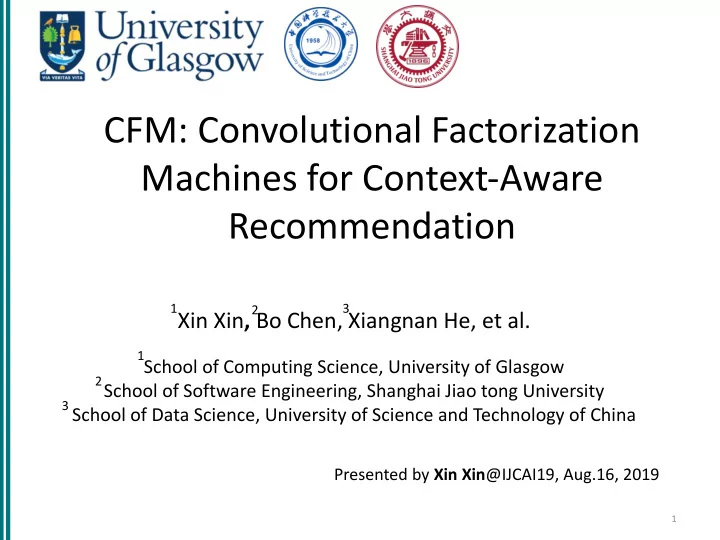

CFM: Convolutional Factorization Machines for Context-Aware Recommendation 1 3 2 Xin Xin , Bo Chen, Xiangnan He, et al. 1 School of Computing Science, University of Glasgow 2 School of Software Engineering, Shanghai Jiao tong University 3 School of Data Science, University of Science and Technology of China Presented by Xin Xin @IJCAI19, Aug.16, 2019 1
Factorization Machines (FM) • FM [Rendel et al., ICDM2010] is one of the most effective feature-based recommendation algorithms 2
Factorization Machines (FM) • FM [Rendel et al., ICDM2010] is one of the most effective feature-based recommendation algorithms • One/Multi-hot feature vectors as inputs – Encodes both item/user side information and context information 3
Factorization Machines (FM) • FM [Rendel et al., ICDM2010] is one of the most effective feature-based recommendation algorithms • One/Multi-hot feature vectors as inputs • Combines linear regression and second-order feature interaction embedding for feature second-order feature interaction linear regression 4
Limitations of FM • Inner product based feature interaction – Embedding dimensions are independent with each other Inner product ? – There may be correlations between different dimensions [Zhang et al., SIGIR2014] • Higher-order interaction & Non-linearity – NFM [He et al., SIGIR2017] – DeepFM [Guo et al., IJCAI2017] 5
Contributions • Utilize an outer product-based interaction cube to represent feature interactions, which encodes both interaction signals and dimension correlations. • Employ 3D CNN above the interaction cube to capture high-order interactions in an explicit way. • Leverage an attention mechanism to perform feature pooling, reducing time complexity. 6
Convolutional Factorization Machines (CFM) • Prediction rule: • Overall structure: 7
CFM • Input and Embedding Layer – sparse feature vectors==>embedding table lookup • Attention pooling layer 8
CFM • Input and Embedding Layer – sparse feature vectors==>embedding table lookup • Attention pooling layer – attention score – softmax – weighted sum 9
CFM • Interaction Cube • 3D CNN 10
CFM • Model Training – Pair-wise ranking loss (BPR) [Rendle et al., UAI2009] – L2 regularization – Drop-out 11
Experiments • Research questions: – Does CFM model outperform state-of-the-art methods for top-k recommendation? – How do the special designs of CFM (i.e., interaction cube and 3DCNN) affect the model performance? – What’s the effect of the attention-based feature pooling? • Datasets: – Frappe – Last.fm – MovieLens • Evaluation: – Leave-one-out – HR&NDCG 12
Experiments • Baselines: – PopRank: popularity-based recommendation – FM[Rendle et al., ICDM2010]: original FM with BPR loss – NFM[He et al., SIGIR17]: stacking MLP upon FM – DeepFM[Guo et al., IJCAI2017]: wide&deep+FM – ONCF[He et al., IJCAI2018]: outer product+MF 13
Experiments • RQ1 (performance) Frappe PopRank FM DeepFM NFM ONCF CFM HR@10 0.3493 0.5486 0.6035 0.6197 0.6531 0.6720 NDCG@10 0.1898 0.3469 0.3765 0.3924 0.4320 0.4560 Last.fm PopRank FM DeepFM NFM ONCF CFM HR@10 0.0023 0.2382 0.2612 0.2676 0.3208 0.3538 NDCG@10 0.0011 0.1374 0.1473 0.1488 0.1823 0.1948 Frappe PopRank FM DeepFM NFM ONCF CFM HR@10 0.0235 0.0998 0.1170 0.1192 0.1110 0.1323 NDCG@10 0.0107 0.0452 0.0526 0.0553 0.0514 0.0627 – Deep structure helps to improve FM (DeepFM&NFM) – CFM achieves the best performance 14
Results • RQ2(model ablation) – Interaction cube & 3D CNN 3D architecture helps to improve performance 15
Results • RQ3(feature pooling) – Effect of attention – Run time & performance Attention pooing layer helps to improve both efficiency and effectiveness 16
Conclusion & Future Work • CFM for feature-based recommendation – Outer product-based interaction cube – 3D CNN to explicitly learn high-order interactions – Attention-based feature pooling layer to reduce computational cost • Future work – Improve efficiency – Residual learning 17
Reference • [Rendle et al.,2010] Factorization machines. In ICDM. • [Rendle et al.,2009] Bpr: Bayesian personalized ranking from implicit feedback. In UAI. • [He, et al.,2017] Neural factorization machines for sparse predictive analytics. In SIGIR. • [Guo et al.,2017] Deepfm: A factorization-machine based neural network for ctr prediction. In IJCAI. • [He et al.,2018] Outer product-based neural collaborative filtering. In IJCAI. • [Zhang et al.,2014] Explicit factor models for explainable recommendation based on phrase-level sentiment analysis. In SIGIR. 18
Thank you Q&A 19
Recommend
More recommend